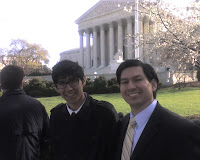I recently went to the U.S. Supreme Court to hear the oral arguments in the case of Carachuri-Rosendo v. Holder. As any good parent would do during Spring Break, I decided to take my 15 year-old son with me. "This case will rock your socks" I promised him, so off we went.
Well, we didn't quite make it to hear Carachuri-Rosendo v. Holder, but we did get to hear a bit of what ended up being Robertson v. U.S. The issue in that case was whether an action for criminal contempt may constitutionally be brought by a private person. Ok, so the issue wasn't as appealing as Carachuri-Rosendo which involved removal based on multiple criminal drug offenses, but we had to do with what we had. The transcript of Carachuri-Rosendo is quite interesting to read.
I honestly thought I was being an overachiever by being in front of the Supreme Court at 8:15am, but to my surprise there were about 150 people ahead of us when we got there. That pretty much quashed any wishful thinking on our part that we would get to hear oral arguments for Carachuri-Rosendo. The line grew even longer shortly after we got there which gave us some twisted hope that we would at least get to see a couple of minutes of the oral arguments. After all, the nice people at the Supreme Court wouldn't let several hundred people wait in line for several hours and not allow them to at least get a peak - right? Well, we had plenty of time to talk with the assistant principal of a school in New Jersey that was in front of us (she was kind enough to take the picture included in this post), and the married couple behind us that were also educators but from Chicago. "It's ok" I would reassure my son, "the second case is even better" (or so I hoped).
We waited in line for about two hours before they split the line into two groups: those that wanted to get a chance to hear the entire second oral argument of Robertson v. U.S. and those that only wanted to hear 3-5 minutes. Apparently the way that it works is that those that were in line early enough could get to hear both the first and second arguments if they wanted to. I figured that those that were brave enough to battle the elements and be there at 6:30am were probably motivated enough to stay for both arguments so we decided to get in the 3-5 minute line. I'm glad we did because from what I could tell only about 15 people decided not to hear the second case and left. After 15 or so people were ushered in to replace those that had left, the guards dismissed the 150+ people from the first line. Among them were the assistant principal from New Jersey and the two teachers from Chicago.
The same day of our visit the U.S. Supreme Court handed down its decision on Padilla v. Kentucky which was argued in October 2009. The U.S. Supreme Court basically held in that case that immigrants have a constitutional right to be told by their lawyers whether pleading guilty to a crime could lead to their deportation. The case, Padilla v. Kentucky, involved a Vietnam War veteran who has resided lawfully in the U.S. for over 40 years. His criminal defense lawyer told him not to worry about the immigration consequences of pleading guilty to a crime, but that advice was wrong. In fact, the guilty plea made Mr. Padilla subject to mandatory deportation from the United States. For more on this very important case you can read SCOTUSwiki or the Washington Post article that recently came out.
In all, being able to see the Justices live was a surreal experience. Albeit for a brief three minutes, seeing and hearing the Justices was well worth the four-hour wait. During our time there we heard Justices Roberts, Scalia, Alito, and Sotomayor involved in quite lively discussions with the attorney arguing the case. If you've never visited the U.S. Supreme Court I encourage you to do so. You will find plenty of useful information about the cases on the U.S. Supreme Court's website, including their Visitor's Guide to Oral Argument and the U.S. Supreme Court Calendar. There are still several oral argument days left in April. Another great resource if you want to read more about the Supreme Court and the cases before the Court is SCOTUSblog or SCOTUSwiki.



